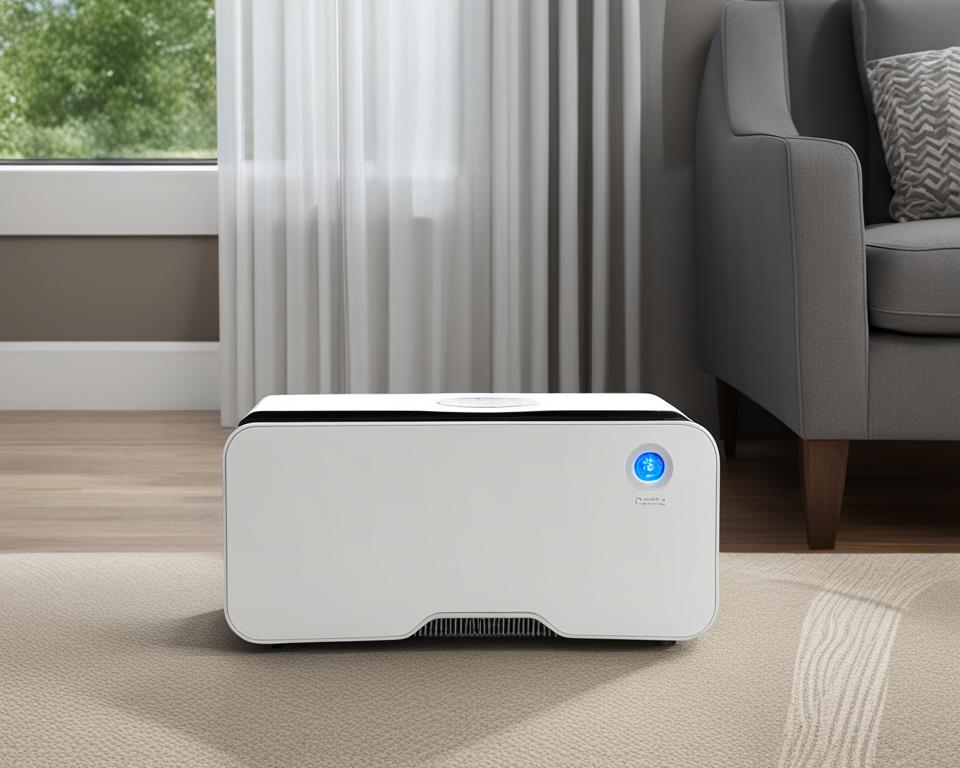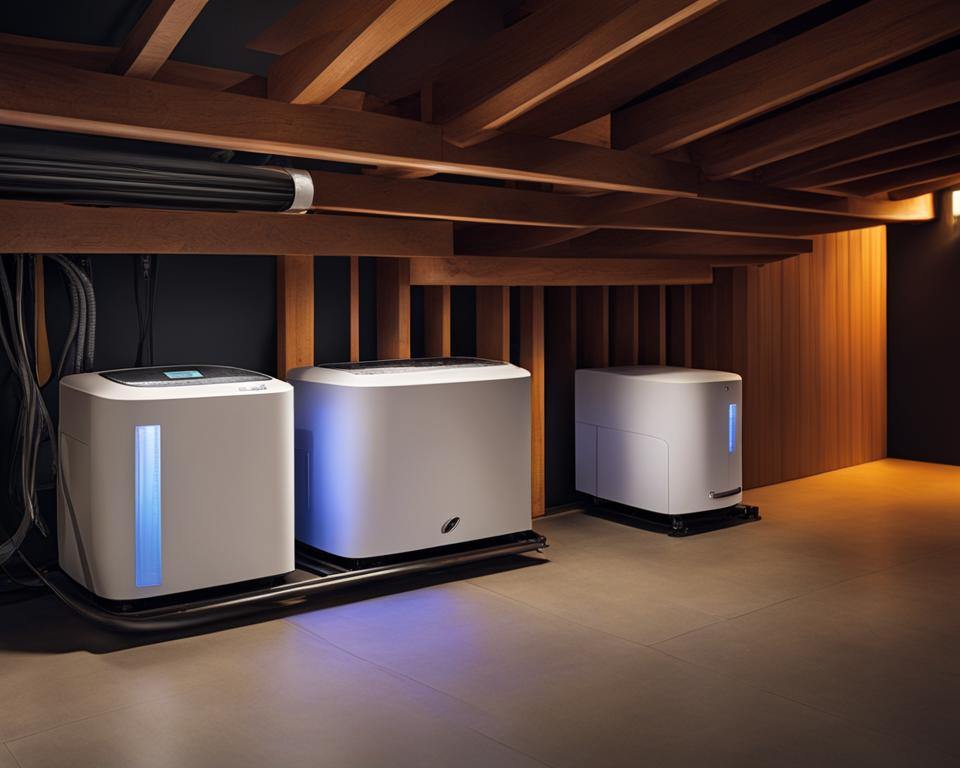In today’s connected world, homeowners are increasingly looking for innovative ways to enhance their living spaces. One area where technology is making a significant impact is in crawl space moisture control. Wi-Fi enabled crawl space dehumidifiers offer advanced solutions for maintaining optimal humidity levels, combating crawl space humidity, and improving indoor air quality. These smart devices come equipped with wireless connectivity, allowing homeowners to easily monitor and adjust humidity levels from the convenience of their smartphones.
With advanced moisture control features, Wi-Fi enabled crawl space dehumidifiers provide a valuable addition to any smart home. Whether it’s preventing mold and mildew growth or ensuring a healthier living environment, these devices offer convenience and efficiency in managing crawl space moisture. Let’s explore the benefits, compatibility with smart home platforms, potential drawbacks, and tips for choosing the right Wi-Fi enabled crawl space dehumidifier.
Key Takeaways:
- Wi-Fi enabled crawl space dehumidifiers provide advanced moisture control for crawl spaces.
- These devices offer wireless connectivity, allowing homeowners to monitor and adjust humidity levels remotely.
- Integration with smart home platforms like Home Assistant can further enhance control and automation capabilities.
- Consider factors such as energy efficiency, noise levels, and compatibility with your preferred smart home platform when choosing a Wi-Fi enabled crawl space dehumidifier.
- Ensure the device is suitable for your crawl space size and capacity requirements.
Benefits of Wi-Fi Enabled Crawl Space Dehumidifiers
Wi-Fi enabled crawl space dehumidifiers offer numerous benefits for homeowners seeking advanced moisture control. The wireless connectivity feature allows for easy monitoring and control of humidity levels from anywhere in the house. This convenience provides peace of mind, as homeowners can address crawl space humidity issues without physically accessing the space. Additionally, these smart dehumidifiers can integrate seamlessly with other smart home devices, enhancing the overall automation and efficiency of the home.
One of the key advantages of Wi-Fi enabled crawl space dehumidifiers is their energy-efficiency. These devices are designed to optimize power consumption, helping to reduce electricity usage and lower utility bills. By utilizing smart technology to regulate humidity levels, they can prevent excessive energy consumption and promote a more sustainable living environment.
Key Benefits:
- Convenient remote monitoring and control of humidity levels
- Seamless integration with other smart home devices
- Energy-efficient operation for reduced electricity consumption
Overall, Wi-Fi enabled crawl space dehumidifiers provide homeowners with enhanced control over crawl space moisture, allowing for a healthier and more comfortable living environment. These devices offer convenience, energy-efficiency, and the ability to integrate with other smart home systems, making them an excellent choice for those seeking advanced crawl space moisture control.
How Wi-Fi Enabled Dehumidifiers Work with Home Assistant
Home Assistant is a popular smart home platform that allows users to control and automate various devices in their homes. While there are limited options for dehumidifiers that can be connected to Home Assistant, some Wi-Fi enabled dehumidifiers, such as the Rohnson Genius, offer integration through the Tuya app. By adding the Tuya integration to Home Assistant, users can control the target humidity and power state of the dehumidifier remotely.
This wireless connectivity for humidity control provides a convenient way to manage the moisture levels in crawl spaces without having to physically access the dehumidifier. Whether you’re at work or on vacation, you can easily monitor and adjust the humidity levels to ensure optimal conditions and prevent mold or mildew growth. With just a few taps on your smartphone, you can have complete control over the dehumidifier’s settings, making it a smart choice for crawl spaces.
While the integration of Wi-Fi enabled dehumidifiers with Home Assistant offers remote control capabilities, it’s important to note that there may be limitations in functionality. While power state control is possible, there may be restrictions on controlling other aspects such as target humidity. It’s crucial to review the specific features and capabilities of the dehumidifier and its integration with Home Assistant to ensure it meets your requirements for crawl space moisture control.

Drawbacks of Wi-Fi Enabled Dehumidifiers
While Wi-Fi enabled dehumidifiers offer convenience and advanced control, there are a few drawbacks to consider. Some users have reported that these dehumidifiers can be quite noisy, which may be a concern for those who prefer a quieter living environment. The noise level can vary depending on the model and its design, so it’s important to read reviews and consider noise levels when choosing a Wi-Fi enabled dehumidifier for your crawl space.
Another drawback is the limited control options available through certain smart home platforms, such as Home Assistant. While power state control is possible, there may be limitations in controlling other aspects, such as target humidity. This can be a disadvantage for those seeking precise control over moisture levels in their crawl space. It’s important to research and understand the capabilities of the smart home platform and its integration with Wi-Fi enabled dehumidifiers before making a purchase.
Additionally, some users have experienced issues with the dehumidifier beeping unnecessarily, which can be disruptive. This may occur due to faulty sensors or inaccurate readings, leading to false alarms. It is important to consider customer reviews and feedback on specific models to determine if such issues are common or isolated incidents.
| Drawbacks of Wi-Fi Enabled Dehumidifiers | Solutions/Considerations |
|---|---|
| Noisy operation | Read reviews to identify quieter models |
| Limited control options through certain smart home platforms | Research capabilities of the chosen smart home platform and dehumidifier integration |
| Unnecessary beeping | Consider customer feedback and reviews to identify models with accurate sensors |
It’s important to weigh the benefits and drawbacks of Wi-Fi enabled dehumidifiers in order to make an informed decision. Despite these drawbacks, many users find that the convenience and advanced moisture control provided by these devices outweigh the limitations. By considering your specific needs and preferences, you can choose a Wi-Fi enabled dehumidifier that best suits your crawl space and smart home integration requirements.
Choosing the Right Wi-Fi Enabled Crawl Space Dehumidifier
When it comes to selecting a Wi-Fi enabled crawl space dehumidifier, there are a few key factors to keep in mind. Firstly, make sure that the device offers wireless connectivity, allowing you to easily control and monitor humidity levels from your smartphone or other smart devices. This feature provides the convenience of remote management, ensuring you can adjust settings anytime and anywhere.
In addition to wireless connectivity, it’s important to choose an energy-efficient crawl space dehumidifier. Look for models that are designed to consume less electricity, as this not only helps you reduce your utility bills but also contributes to a more sustainable and eco-friendly home. Energy-efficient dehumidifiers are optimized to remove excess moisture while minimizing power consumption.
When considering the right dehumidifier for your crawl space, take into account its size and capacity. The unit should be appropriately sized to effectively cover the square footage of your crawl space and provide efficient moisture control. An undersized dehumidifier may struggle to adequately reduce humidity levels, while an oversized unit may consume unnecessary energy.
To make an informed decision, it’s always beneficial to read reviews and compare features of different Wi-Fi enabled crawl space dehumidifiers. This allows you to gather insights from other homeowners’ experiences and understand the performance and reliability of various models. By considering these factors and prioritizing wireless connectivity, energy efficiency, proper sizing, and informed comparisons, you can choose the right Wi-Fi enabled crawl space dehumidifier for your home.
FAQ
What are the benefits of Wi-Fi enabled crawl space dehumidifiers?
Wi-Fi enabled crawl space dehumidifiers offer wireless connectivity, allowing homeowners to monitor and control humidity levels from anywhere in the house using their smartphones. These smart dehumidifiers also integrate seamlessly with other smart home devices and are energy-efficient, helping to reduce electricity consumption and lower utility bills.
How do Wi-Fi enabled dehumidifiers work with Home Assistant?
While there are limited options for dehumidifiers that can be connected to Home Assistant, some Wi-Fi enabled dehumidifiers, such as the Rohnson Genius, offer integration through the Tuya app. By adding the Tuya integration to Home Assistant, users can control the target humidity and power state of the dehumidifier remotely, providing advanced moisture control in crawl spaces.
What are the drawbacks of Wi-Fi enabled dehumidifiers?
Some users have reported that these dehumidifiers can be noisy, which may be a concern for those who prefer a quieter living environment. Additionally, there may be limited control options available through certain smart home platforms, and some users have experienced issues with unnecessary beeping from the dehumidifier.
How do I choose the right Wi-Fi enabled crawl space dehumidifier?
When selecting a Wi-Fi enabled crawl space dehumidifier, consider factors such as wireless connectivity and compatibility with your preferred smart home platform. Look for energy-efficient models, consider the size and capacity of the dehumidifier, and read reviews and compare features to make an informed decision.

Leave a Reply